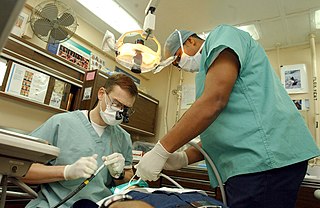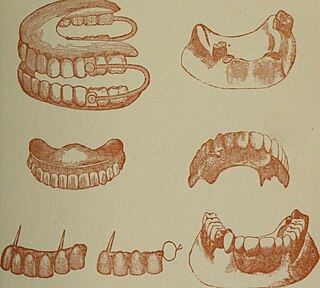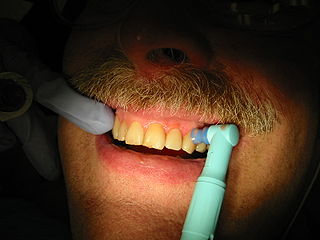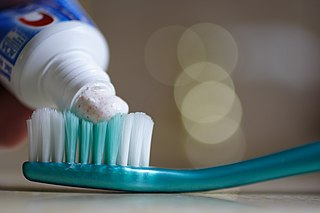
Dentistry, also known as dental medicine and oral medicine, is the branch of medicine focused on the teeth, gums, and mouth. It consists of the study, diagnosis, prevention, management, and treatment of diseases, disorders, and conditions of the mouth, most commonly focused on dentition as well as the oral mucosa. Dentistry may also encompass other aspects of the craniofacial complex including the temporomandibular joint. The practitioner is called a dentist.

A dentist, also known as a dental surgeon, is a health care professional who specializes in dentistry, the branch of medicine focused on the teeth, gums, and mouth. The dentist's supporting team aids in providing oral health services. The dental team includes dental assistants, dental hygienists, dental technicians, and sometimes dental therapists.
Teeth cleaning is part of oral hygiene and involves the removal of dental plaque from teeth with the intention of preventing cavities, gingivitis, and periodontal disease. People routinely clean their own teeth by brushing and interdental cleaning, and dental hygienists can remove hardened deposits (tartar) not removed by routine cleaning. Those with dentures and natural teeth may supplement their cleaning with a denture cleaner.
The American Dental Association (ADA) is an American professional association established in 1859 which has more than 161,000 members. Based in the American Dental Association Building in the Near North Side of Chicago, the ADA is the world's largest and oldest national dental association. The organization lobbies on behalf of the American dental profession and provides dental accreditation.

A dental hygienist or oral hygienist is a licensed dental professional, registered with a dental association or regulatory body within their country of practice. Prior to completing clinical and written board examinations, registered dental hygienists must have either an associate's or bachelor's degree in dental hygiene from an accredited college or university. Once registered, hygienists are primary healthcare professionals who work independently of or alongside dentists and other dental professionals to provide full oral health care. They have the training and education that focus on and specialize in the prevention and treatment of many oral diseases.
Periodontology or periodontics is the specialty of dentistry that studies supporting structures of teeth, as well as diseases and conditions that affect them. The supporting tissues are known as the periodontium, which includes the gingiva (gums), alveolar bone, cementum, and the periodontal ligament. A periodontist is a dentist that specializes in the prevention, diagnosis and treatment of periodontal disease and in the placement of dental implants.

Dental assistants are members of the dental team. They support a dental operator in providing more efficient dental treatment. Dental assistants are distinguished from other groups of dental auxiliaries by differing training, roles and patient scopes.

A denturist in the United States and Canada, clinical dental technologist in the United Kingdom and Ireland, dental prosthetist in Australia, or a clinical dental technician in New Zealand is a member of the oral health care team and role as primary oral health care provider who provides an oral health examination, planning treatment, takes impressions of the surrounding oral tissues, constructs and delivers removable oral prosthesis treatment directly to the patient.

The American Student Dental Association (ASDA) is a national student-run organization that is concerned with the rights, interests, and welfare of dental students. It has the aim of introducing students to lifelong involvement in organized dentistry and provides services, information, education, representation, and advocacy.
A dental therapist is a member of the dental team who provides preventive and restorative dental care for children and adults. The precise role varies and is dependent on the therapist's education and the various dental regulations and guidelines of each country.
The Melbourne Dental School is one of the graduate schools of the University of Melbourne. In addition to the 4-year graduate dental program the Doctor of Dental Surgery, the school offers specialty training programs combined with the Doctor of Clinical Dentistry degree, advanced training programs, and research degrees including M.Sc. and Ph.D. programs. According to the QS World Rankings, it is the highest ranking dental school in Australia and often ranks among the top 25 in the world.

Dental Public Health (DPH) is a para-clinical specialty of dentistry that deals with the prevention of oral disease and promotion of oral health. Dental public health is involved in the assessment of key dental health needs and coming up with effective solutions to improve the dental health of populations rather than individuals.
Alfred Civilion Fones was an American dentist from Bridgeport, Connecticut, who has been called the founder of the profession of dental hygiene, starting in 1906. Fones created the name "dental hygienist" and in 1913 established the first school of dental hygiene. Fone's father was mayor of Bridgeport from 1886 to 1888 and was also a practicing dentist, becoming the first "dental commissioner" for the City of Bridgeport. Alfred Fones graduated from the New York College of Dentistry in 1890.

Tooth polishing procedures are done to smooth the surfaces of teeth and restorations. The purpose of polishing is to remove extrinsic stains, remove dental plaque accumulation, increase aesthetics and to reduce corrosion of metallic restorations. Tooth polishing has little therapeutic value and is usually done as a cosmetic procedure after debridement and before fluoride application. Common practice is to use a prophy cup—a small motorized rubber cup—along with an abrasive polishing compound.

Oral hygiene is the practice of keeping one's oral cavity clean and free of disease and other problems by regular brushing of the teeth and adopting good hygiene habits. It is important that oral hygiene be carried out on a regular basis to enable prevention of dental disease and bad breath. The most common types of dental disease are tooth decay and gum diseases, including gingivitis, and periodontitis.

Gingivitis is a non-destructive disease that causes inflammation of the gums; ulitis is an alternative term. The most common form of gingivitis, and the most common form of periodontal disease overall, is in response to bacterial biofilms that are attached to tooth surfaces, termed plaque-induced gingivitis. Most forms of gingivitis are plaque-induced.
Special needs dentistry, also known as special care dentistry, is a dental specialty that deals with the oral health problems of geriatric patients, patients with intellectual disabilities, and patients with other medical, physical, or psychiatric issues.

The University of Minnesota School of Dentistry is the dental school of the University of Minnesota. It is located in Minneapolis, Minnesota, United States.

The University of Michigan School of Dentistry is the dental school of the University of Michigan, a public research university located in Ann Arbor, Michigan. Established in 1875, the School of Dentistry engages in oral and craniofacial health care education, research, patient care and community service.
Esther Mae Wilkins was an American dental hygienist, dentist and author of the first comprehensive book on dental hygiene, Clinical Practice of the Dental Hygienist. The dental instrument known as the Wilkins/Tufts Explorer was named after her.













